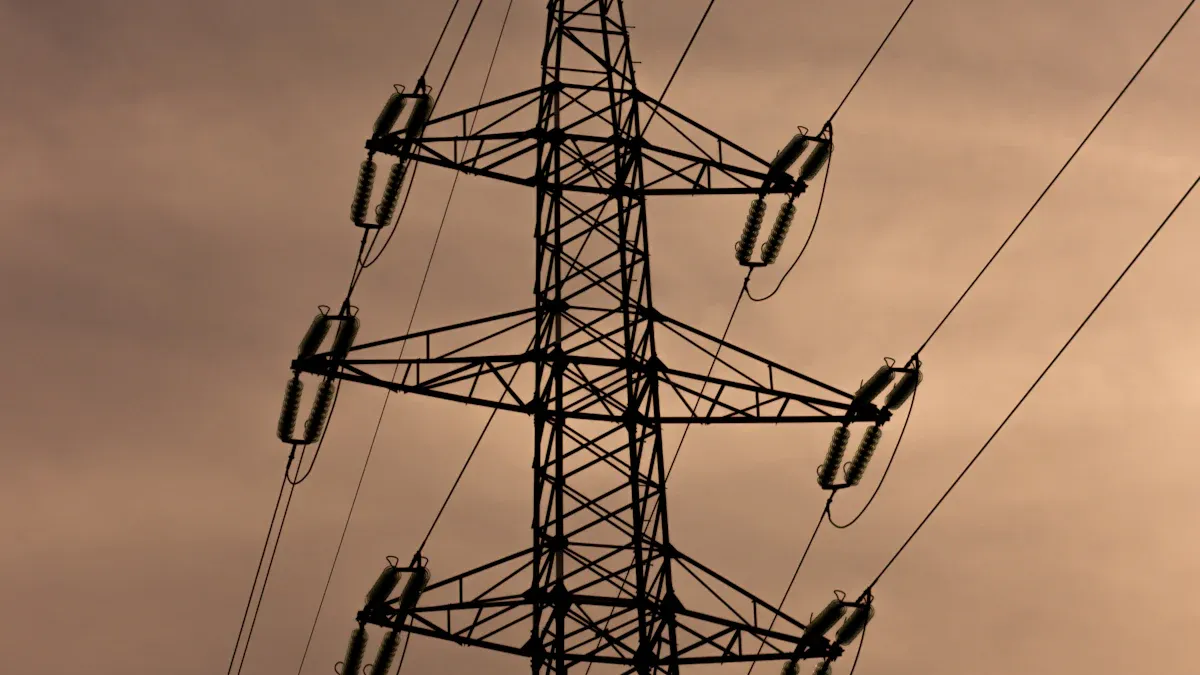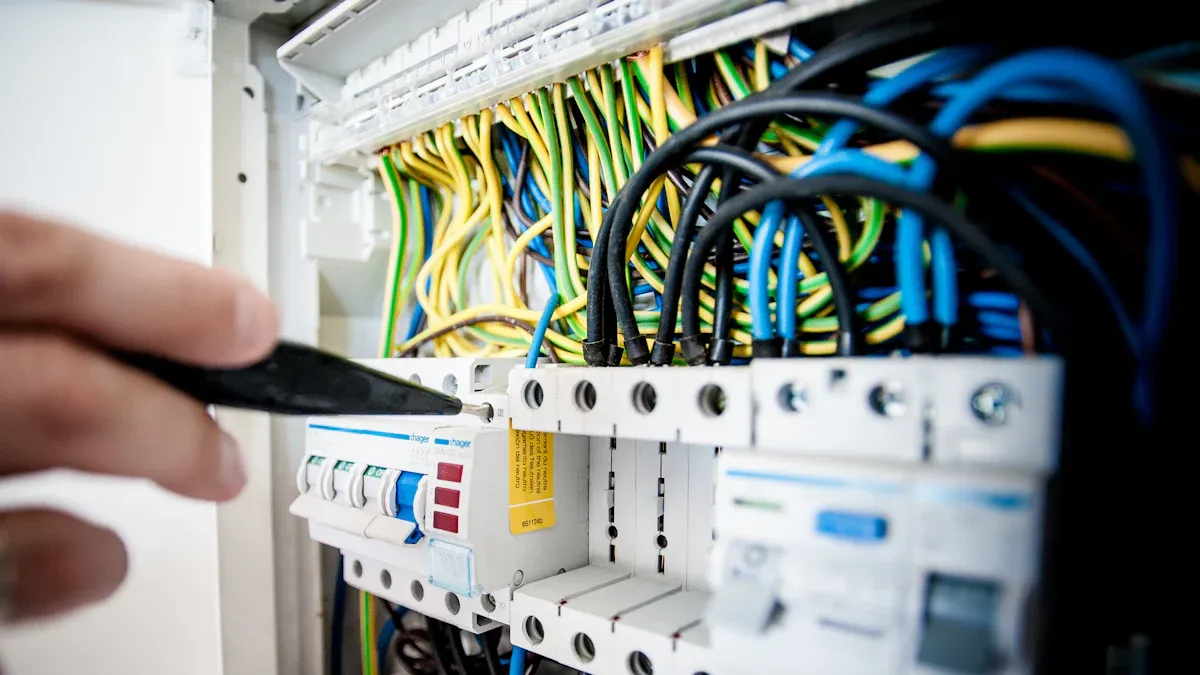What Makes PET Shrink Tubing Ideal for High Dielectric Strength Uses

PET shrink tubing stands out as a high-performance insulation material in modern industries. Its high dielectric strength, exceeding 500 volts per mil, ensures exceptional electrical insulation. Thin walls and robust mechanical strength allow it to fit seamlessly into compact spaces without compromising durability. Its thermal stability, reaching up to 125°C, makes it suitable for demanding environments. Industries like smartphone manufacturing and industrial control panels increasingly adopt this tubing due to its unmatched performance. The high dielectric strength PET shrink tube also resists chemicals better than traditional PVC, enhancing its reliability in harsh conditions.
Key Takeaways
PET shrink tubing has strong electrical insulation, over 500 volts per mil.
It can handle heat up to 150°C, so it works well in hot places like car engines.
The tubing resists damage from oils and chemicals, making it last longer and need less fixing.
It shrinks tightly around wires and parts, saving material and improving insulation.
Industries like cars, planes, and healthcare use it because it is tough and useful for many jobs.
What Is PET Heat Shrink Tubing?
Definition and Overview
PET heat shrink tubing, also known as polyethylene terephthalate heat shrink tubing, is a versatile and high-performance material used for insulation and protection in various industries. It is made from polyethylene terephthalate, a thermoplastic polymer known for its exceptional mechanical strength, chemical resistance, and thermal stability. This tubing is designed to shrink when exposed to heat, conforming tightly to the shape of the object it covers. Its ability to provide a secure and protective layer makes it an essential component in applications requiring reliable insulation and durability.
PET heat shrink tubing is widely used in industries such as automotive, aerospace, electrical, and medical. Its cost-effectiveness and adaptability make it a preferred choice for both standard and specialized applications. The table below highlights some of its key properties and applications:
Property/Application | Description |
|---|---|
Mechanical Strength | Exhibits high tensile strength and abrasion resistance, suitable for demanding applications. |
Chemical Resistance | Resistant to a wide range of chemicals, oils, and solvents, ensuring protection from corrosive substances. |
Thermal Stability | Can withstand continuous operating temperatures up to 150°C (302°F). |
Tight Conformity | Conforms tightly to the shape of the object, providing a secure and protective covering. |
Cost-Effectiveness | Generally more cost-effective compared to FEP, making it attractive for budget-conscious applications. |
Automotive Industry | Used for wire harnessing, lithium batteries, and protection of components in automotive applications. |
Widely used for insulating and protecting wires, cables, and connectors. | |
Aerospace and Defense | Mechanical strength and thermal stability make it suitable for aerospace and defense applications. |
Used for catheter manufacturing and insulation of wires and cables in medical devices. | |
General Industrial Applications | Used for insulation, bundling, and protection of components in machinery and equipment. |
Key Characteristics of PET Heat Shrink Tubing
PET heat shrink tubing offers a unique combination of properties that make it ideal for high-performance applications. These characteristics include:
High Dielectric Strength: With a dielectric strength exceeding 4,000 V/mil, PET heat shrink tubing provides excellent electrical insulation.
Thermal Stability: It can operate continuously at temperatures up to 150°C (302°F) and withstand short-term exposure to 200°C (392°F).
Chemical Resistance: The tubing resists oils, solvents, and corrosive chemicals, ensuring long-term durability in harsh environments.
Mechanical Strength: Its high tensile strength and abrasion resistance make it suitable for demanding applications.
Precision Shrinkage: PET heat shrink tubing shrinks uniformly when heated, providing a tight and secure fit around the object.
These features make PET heat shrink tubing a reliable solution for protecting wires, cables, and sensitive components in various industries.
How PET Heat Shrink Tubing Works
PET heat shrink tubing works by utilizing the thermoplastic properties of polyethylene terephthalate. During manufacturing, the tubing undergoes a process called "orientation," where it is stretched and then cooled to lock in its expanded shape. When exposed to heat, the tubing returns to its original dimensions, shrinking tightly around the object it covers.
Key aspects of how PET heat shrink tubing functions include:
Shrinkage Properties: The tubing can reduce its diameter by up to 70% while maintaining its strength.
Temperature Range: It shrinks effectively within a temperature range of 70°C (158°F) to 190°C (374°F), with optimal performance at 150°C (302°F).
Radial and Axial Shrinkage: The tubing shrinks both radially and axially, ensuring a snug fit. Applying axial tension during heating can enhance radial shrinkage, achieving up to 50% or more.
The table below provides additional technical details about PET heat shrink tubing's performance under different conditions:
Property | Value |
|---|---|
Dielectric strength | > 4,000 V/mil |
Dielectric constant | 3.3 |
Dissipation factor | 0.0025 |
Volume resistivity | 10^18 Ohm-cm |
Surface resistivity | 10^14 Ohm/square |
Shrinking temperature | 70°C (158°F)–190°C (374°F) |
Recommended shrinking temp | 150°C (302°F) |
Long-term use (cryogenic) | -196°C (-320.8°F)–135°C (275°F) |
Short-term use | Up to 200°C (392°F) |
Melting point | 235°C (455°F) |
By leveraging these properties, PET heat shrink tubing provides reliable insulation and protection for a wide range of applications.
Understanding Dielectric Strength in Insulation

Definition of Dielectric Strength
Dielectric strength refers to the maximum electric field an insulating material can withstand without breaking down or becoming conductive. This property is critical for ensuring the reliability of electrical insulation in various applications. Materials with high dielectric strength can resist electrical stress, even under challenging environmental conditions. For instance, electric mobility systems require thin insulation layers with superior dielectric properties to maintain safety and performance. The ability of insulation to endure high voltages without failure directly impacts the efficiency and safety of electrical systems.
Importance of Dielectric Strength in Electrical Insulation
Dielectric strength plays a vital role in determining the effectiveness of electrical insulation. It ensures that insulating materials can handle high voltages without compromising their integrity. Several factors highlight its importance:
Dielectric resistance measures how well insulation withstands electrical stress, preventing system failures.
The maximum voltage an insulating material can endure safeguards electrical safety in critical applications.
Inadequate insulation contributes to a significant percentage of electrical accidents, emphasizing the need for regular assessments.
Effective evaluations of insulation can reduce electrical shocks by up to 30%, enhancing workplace safety.
These points underscore the necessity of using materials with high dielectric strength in industries like automotive, aerospace, and medical devices.
Factors Affecting Dielectric Strength in Materials
Several measurable factors influence the dielectric strength of insulating materials. These factors determine how well a material performs under varying conditions:
Measurable Factor | Description |
|---|---|
Dielectric Strength | Indicates the maximum electric field a material can withstand without breakdown. Higher values signify better insulation. |
Thermal Stability | Refers to the ability of materials to maintain their properties under varying temperatures, crucial for industrial use. |
Moisture Resistance | The capacity of materials to resist moisture, essential for maintaining insulation in humid environments. |
Materials with high dielectric strength, excellent thermal stability, and strong moisture resistance are ideal for applications requiring reliable insulation. These properties ensure durability and safety in environments where electrical stress and environmental factors pose challenges.
Properties of High Dielectric Strength PET Shrink Tube
Mechanical Strength and Thin-Wall Design
The mechanical strength of high dielectric strength PET shrink tube makes it a reliable choice for demanding applications. This tubing exhibits exceptional tensile strength, allowing it to withstand physical stress without tearing or deforming. Its robust structure ensures durability, even in environments with frequent mechanical vibrations or impacts.
The thin-wall design of PET shrink tubing enhances its versatility. It provides effective insulation without adding unnecessary bulk, making it ideal for compact spaces. Industries such as electronics and automotive benefit from this feature, as it allows for efficient use of space while maintaining high performance.
Tip: The combination of mechanical strength and a thin-wall design ensures that PET shrink tubing delivers both durability and flexibility, making it suitable for a wide range of applications.
Thermal Stability and Low Recovery Temperature
High dielectric strength PET shrink tube demonstrates excellent thermal stability. It can operate continuously at temperatures up to 150°C (302°F) and withstand short-term exposure to even higher temperatures. This property ensures that the tubing maintains its integrity in high-temperature environments, such as those found in automotive engines or industrial machinery.
The low recovery temperature of PET shrink tubing is another critical feature. It begins to shrink at temperatures as low as 70°C (158°F) and achieves optimal performance at 150°C (302°F). This low recovery temperature minimizes the risk of heat damage to sensitive components during installation.
Property | Value |
|---|---|
Continuous Operating Temp | Up to 150°C (302°F) |
Short-Term Exposure | Up to 200°C (392°F) |
Shrinking Temperature | 70°C (158°F)–190°C (374°F) |
This combination of thermal stability and low recovery temperature makes PET shrink tubing a dependable solution for applications requiring high-temperature resistance and precision.
Chemical Resistance and Environmental Durability
The chemical resistance of high dielectric strength PET shrink tube ensures long-term performance in harsh environments. It resists oils, solvents, and corrosive chemicals, making it suitable for use in industries where exposure to such substances is common. For example, in the automotive sector, this tubing protects electrical components from engine oils and other fluids.
Environmental durability further enhances the reliability of PET shrink tubing. It withstands UV radiation, moisture, and extreme weather conditions, ensuring consistent performance in outdoor applications. This durability reduces the need for frequent replacements, saving time and costs for businesses.
Note: The chemical resistance and environmental durability of PET shrink tubing make it an excellent choice for industries that demand reliable insulation in challenging conditions.
Precision Shrinkage for Electrical Insulation
Precision shrinkage plays a critical role in ensuring effective electrical insulation. PET shrink tubing demonstrates exceptional shrinkage characteristics, making it a preferred choice for applications requiring reliable insulation. Its ability to conform tightly to irregular shapes enhances its performance in protecting wires, cables, and connectors.
The shrinkage ratios of PET shrink tubing highlight its precision. The transverse direction (TD) shrinkage ratio exceeds 75%, while the machine direction (MD) shrinkage ratio remains approximately 0%, with a tolerance of +/- 3%. These measurements indicate that the tubing shrinks efficiently in one direction while maintaining stability in the other. This controlled shrinkage ensures a snug fit without compromising the structural integrity of the insulated components.
PET shrink tubing offers various shrinkage options, including ratios of 2:1, 3:1, and 4:1. These ratios represent the inner diameter before shrinkage divided by the inner diameter after shrinkage. Higher shrinkage ratios provide better adaptability for wrapping connectors and cables, ensuring comprehensive coverage and enhanced electrical insulation. For instance, a 4:1 ratio is particularly effective for insulating components with significant size variations.
The precision of PET shrink tubing extends beyond its shrinkage ratios. Its uniform radial and axial shrinkage ensures consistent coverage, even in challenging applications. This uniformity minimizes gaps or weak points, which could compromise insulation. Additionally, the tubing's ability to shrink at low temperatures reduces the risk of heat damage to sensitive components, further enhancing its performance.
Industries rely on PET shrink tubing for its reliable insulation and consistent performance. Its precision shrinkage capabilities make it suitable for high-performance applications in sectors such as automotive, aerospace, and medical devices. By delivering a secure and protective layer, PET shrink tubing ensures the safety and efficiency of electrical systems.
Note: The precision shrinkage of PET shrink tubing not only improves its performance but also reduces material waste, making it an environmentally friendly choice for insulation needs.
Applications of PET Heat Shrink Tubing in Electrical Insulation

Electrical Industry: Insulation for Wires and Cables
PET heat shrink tubing plays a vital role in insulating wires and cables in the electrical industry. Its high dielectric strength ensures effective electrical insulation, preventing short circuits and enhancing safety in critical systems. The tubing's thin-wall design allows it to fit snugly around wires without adding bulk, making it ideal for compact circuits in modern electronics.
The durability of PET shrink tubing ensures long-term reliability, even in environments with fluctuating temperatures or exposure to moisture. Its chemical resistance protects electrical connections from corrosive substances, reducing the risk of electrical failures. By insulating wires and cables effectively, PET shrink tubing enhances the performance and safety of electrical systems in residential, commercial, and industrial applications.
Automotive Industry: Protection for Electrical Components
In the automotive sector, PET heat shrink tubing provides reliable protection for electrical components. It safeguards circuits and electrical connections in vehicles, particularly in electric vehicles (EVs), where insulation is critical for preventing electrical failures. The tubing resists moisture and contaminants, ensuring the reliability and longevity of electrical systems.
The demand for PET shrink tubing continues to grow due to its effectiveness in protecting electrical connections in harsh environments. Its thermal stability and chemical resistance make it suitable for use in engine compartments and other high-temperature areas. By preventing short circuits and enhancing durability, PET shrink tubing contributes to the safety and efficiency of modern automotive systems.
Aerospace Industry: Ensuring Safety in High-Voltage Systems
The aerospace industry relies on PET heat shrink tubing for its exceptional electrical insulation properties. High-voltage systems in aircraft require materials that can withstand extreme conditions while maintaining safety and reliability. PET shrink tubing meets these demands with its high dielectric strength, thermal stability, and resistance to environmental factors.
In aerospace applications, the tubing protects circuits from short circuits and electrical failures caused by temperature fluctuations, vibration, and exposure to chemicals. Its precision shrinkage ensures a secure fit around components, providing reliable protection in critical systems. By enhancing the durability and safety of electrical systems, PET shrink tubing supports the stringent requirements of the aerospace industry.
Tip: PET shrink tubing's ability to combine insulation, durability, and reliability makes it an indispensable material for industries requiring high-performance protective solutions.
Medical Devices: Insulation for Sensitive Equipment
PET heat shrink tubing plays a critical role in the medical industry by providing reliable insulation for sensitive equipment. Medical devices often operate in environments where precision and safety are paramount. PET shrink tubing ensures that electrical components remain insulated, reducing the risk of malfunctions during critical procedures. Its high dielectric strength and thermal stability make it an ideal choice for medical applications requiring consistent performance.
One notable example of its application is in the assembly of radiofrequency ablation (RFA) needles. These needles are used in minimally invasive procedures to treat conditions such as chronic pain or tumors. PET shrink tubing provides insulation and structural stability to the RFA needle, ensuring that it functions effectively during procedures. This insulation safeguards the integrity of the equipment while protecting patients from potential electrical hazards.
The chemical resistance of PET shrink tubing further enhances its suitability for medical devices. It withstands exposure to sterilization processes, including autoclaving and chemical cleaning, without degrading. This durability ensures that medical equipment remains safe and functional over repeated uses.
Tip: The ability of PET shrink tubing to endure sterilization processes makes it a cost-effective solution for reusable medical devices.
In addition to its functional benefits, PET shrink tubing offers precision shrinkage, allowing it to conform tightly to irregular shapes. This feature is particularly valuable in medical devices with intricate designs, such as catheters or diagnostic probes. By providing a secure fit, the tubing enhances the reliability of these devices in high-stakes environments.
The combination of insulation, durability, and adaptability makes PET shrink tubing an indispensable material in the medical field. Its role in ensuring the safety and efficiency of sensitive equipment highlights its importance in advancing modern healthcare technologies.
PET shrink tubing offers unmatched performance for applications demanding high dielectric strength. Its mechanical strength, thermal stability, and chemical resistance ensure reliability in challenging environments. Industries value its versatility, as it supports diverse needs, from electrical insulation to medical device protection.
Key Features:
High strength and durability
Biocompatibility and ISO 10993 compliance
Heat resistance and flexibility
Year | Market Value (in million USD) | Projected Growth |
|---|---|---|
2022 | 150 | - |
2033 | 600 |
This growth reflects its role in enhancing safety, efficiency, and durability across sectors.
FAQ
What makes PET shrink tubing different from other insulation materials?
PET shrink tubing stands out due to its high dielectric strength, thermal stability, and chemical resistance. It offers a thin-wall design and precision shrinkage, making it ideal for compact and demanding applications. These features ensure reliable insulation and protection in various industries.
How does PET shrink tubing perform in high-temperature environments?
PET shrink tubing performs exceptionally well in high-temperature conditions. It operates continuously at temperatures up to 150°C and withstands short-term exposure to 200°C. Its thermal stability ensures durability and consistent performance in challenging environments like automotive engines or industrial machinery.
Can PET shrink tubing resist chemicals and environmental factors?
Yes, PET shrink tubing resists oils, solvents, and corrosive chemicals. It also withstands UV radiation, moisture, and extreme weather conditions. These properties make it suitable for outdoor and harsh industrial applications, ensuring long-term reliability and reduced maintenance needs.
What industries benefit most from PET shrink tubing?
Industries such as automotive, aerospace, electrical, and medical benefit significantly from PET shrink tubing. Its high dielectric strength, precision shrinkage, and durability make it ideal for protecting wires, cables, and sensitive components in these sectors.
Is PET shrink tubing environmentally friendly?
PET shrink tubing minimizes material waste due to its precision shrinkage and long lifespan. Its durability reduces the need for frequent replacements, making it a sustainable choice for insulation and protection in various applications.
See Also
Exploring Heat Shrink Tubing Applications for Electrical Insulation
Essential Insights on PET Heat Shrink Tubing for Electronics
The Importance of Ultra-Thin PET Heat Shrink Tubing in Medicine
Selecting Optimal Ultra-Thin PET Heat Shrink Tubing for Projects
Comparing FEP and PTFE Heat Shrink Tubing for Chemical Durability

